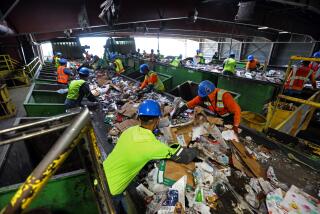CHEMICAL WARFARE
- Share via
World War I saw the first use of chemical agents, and they were used in several conflicts through the 1930s. Although chemical weapons were not used in World War II, their use was suspected in Southeast Asia and Afghanistan in the early 1980s--and confirmed during the 8-year Iran-Iraq War. PREVENTION AND CLEANUP:
U.S. soldiers are well prepared for chemical attack. They wear both a gas mask and hood which protect the wearer’ head and neck. To protect the body, the soldier wears gloves, overboots and a two-piece suit (an outer layer of nylon/cotton and an inner layer of charcoal-impregnated polyurethane foam.)
After soldiers are contaminated, they are taken to specially marked yellow tents beside hospital units. Medics cut off their chemical suits and wash them in a bleach-like liquid. Alternative treatment include applying fuller’s earth, an absorbent clay, to soak up chemical agents or covering with charcoal-lined bags. CHEMICAL WEAPONS AND HOW THEY AFFECT THE BODY: Nerve Agents: Entry: Breathing, skin Effects: Nervous system Inhaled or absorbed through the skin, these agents prevent the normal functioning of the nervous system. Death usually results from respiratory failure. Iraq is known to have Tabun, an early nerve gas and possibly Sarin, a much more sophisticated and deadly type. Lung Agents: Entry: Breathing Effects: Lungs Inhaled into the lungs, agents such as chlorine gas cause massive irritation to the respiratory system. Drowning results as the damaged lungs fill with fluid. Gas masks provide adequate protection against some of these agents. Blood Agents: Entry: Breathing Effects: Circulation system Absorbed primarily by breathing, blood agents such as hydrogen cyanide block the normal transfer of oxygen between blood and body tissue, resulting in suffocation. Gas masks are effective in blocking these types of agents. Blister Agents: Entry: Breathing, skin Effects: Lungs, skin Blister agents, inhaled or absorbed through the skin, are insidious in action: there is little pain at contact, but after a short time the victim develops large blisters. Known as mustard gas, blister agents are seldom fatal, but permanently damage lungs and skin Iraq used this gas extensively in its 8-year war with Iran. HISTORY
According to the Stockholm International Peace Research Institute, at one time as many as 38 countries were pursuing chemical weapons programs. However, in the 1980s that number dropped to about 16 nations, with only 10 having confirmed stockpiles. Confirmed Chemical Programs: 1. U.S. 2. Soviet Union 3. France 4. Afghanistan 5. Iran 6. Iraq 7. Libya 8. Syria 9. Vietnam 10. N. Korea Suspected Chemical Programs: 11. Israel 12. Egypt 13. Ethiopia 14. Burma 15. Taiwan 16. China Iraq and Chemical Warfare: Defying international bans, Iraq launched poison gas attacks against Iranian forces and Kurdish rebels in the mid-1980s. Iraq produced numerous deadly chemicals--including sophisticated nerve gases. Recent allied air strikes have been successful in destroying most of Iraq’s ability to produce chemical agents, but reportedly large stockpiles remain intact.
SOURCE: U.S. Strategic Institute, Federation of American Scientists, Jane’s NBC Protection Equipment, Associated Press
More to Read
Sign up for Essential California
The most important California stories and recommendations in your inbox every morning.
You may occasionally receive promotional content from the Los Angeles Times.










